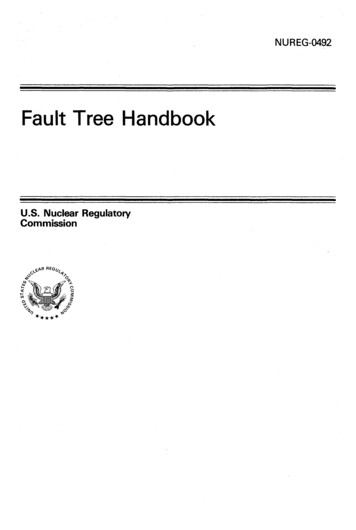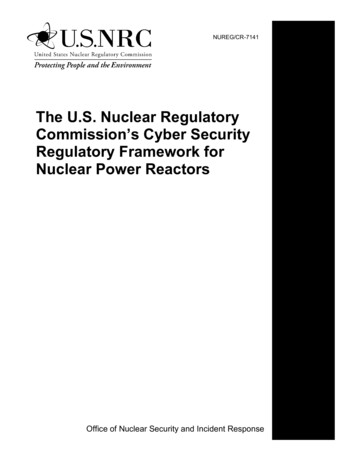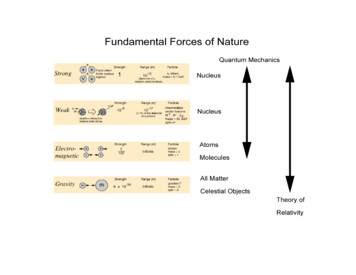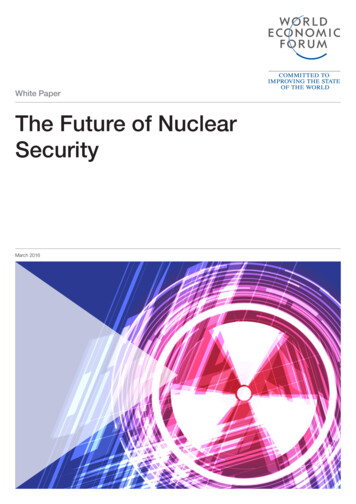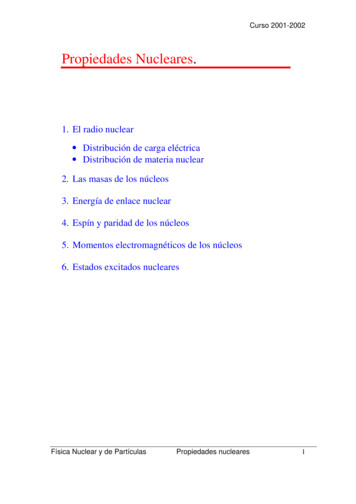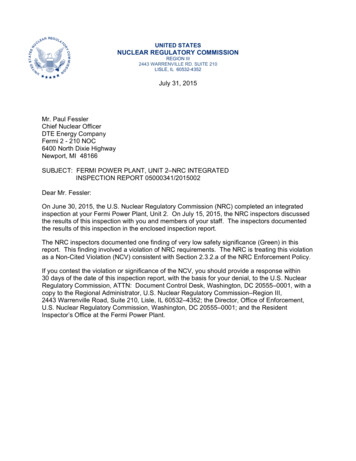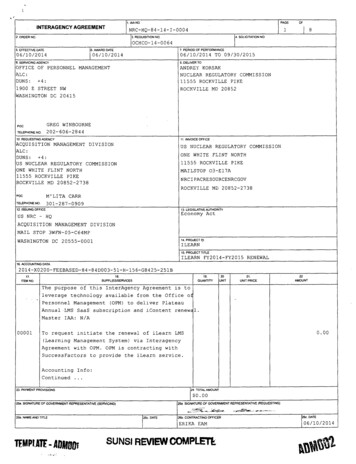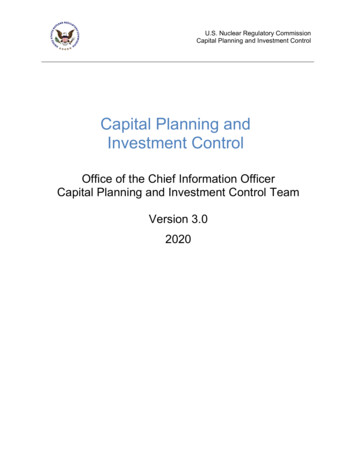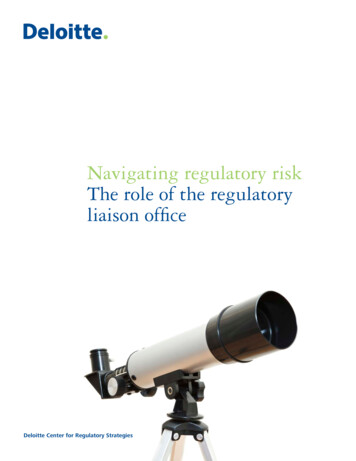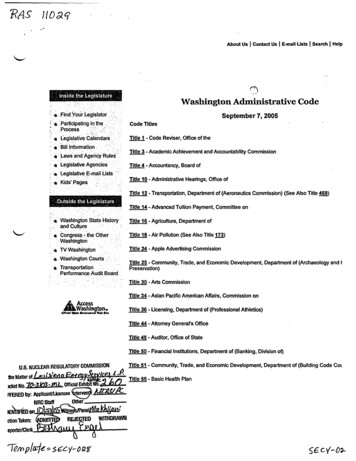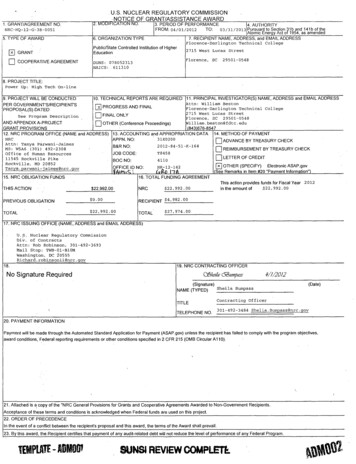
Transcription
U.S. NUCLEAR REGULATORY COMMISSION. NOTICE OF GRANT/AS.ISTANCF AWARD1. GRANT/AGREEMENT NO.NRC-HQ-12-G-38-0051,5. TYPE OF AWARD3. PERIOD OF PERFORMANCE4. AUTHORITYFROM: 04/01/2012TO:03/31/2013 Pursuant to Section 31b and 141b of theAtomic Energy Act of 1954, as amended6. ORGANIZATION TYPE7. RECIPIENT NAME, ADDRESS, and EMAIL ADDRESSFlorence-Darlington Technical CollegePublic/State Controlled Institution of Higher2715 West Lucas street2. MODIFICATION NO.Mx GRANTEducationM COOPERATIVE AGREEMENTDUNS: 078052313NAICS: 611310Florence,SC29501-05488. PROJECT TITLE:Power Up: High Tech On-line10. TECHNICAL REPORTS ARE REQUIRED 11. PRINCIPAL INVESTIGATOR(S) NAME, ADDRESS and EMAIL ADDRESSAttn: William BestonM PROGRESS AND FINALTechnical collegePFlorence-DarlingtonFINALONLY12715 West Lucas StreetSee Program DescriptionFIOFlorence,SC 29501-0548AND APPENDIX A-PROJECTM OTHER (Conference Proceedings)William. beston@fdtc .eduGRANT PROVISIONS(843)676-854712. NRC PROGRAM OFFICE (NAME and ADDRESS) 13.-ACCOUNTING and APPROPRIATION DATA14. METHOD OF PAYMENTNRCAPPN. NO:31X0200EZ ADVANCE BY TREASURY CHECKAttn: Tanya Parwani-JaimesB&R NO:2012-84-51-K-164MS : W5A6.(301) 492-2308--] REIMBURSEMENT BY TREASURY CHECKoffice of Human ResourcesJOB CODE:T845811545 Rockville PikeBOC NO:4110Rockville, MD 20852OFFICE ID NOHR-12-142WOTHER (SPECIFY)Electronic ASAP.gov-- prn-ams1: 1--41-76(See Remarks in Item #20 "Payment Information")9. PROJECT WILL BE CONDUCTEDPER GOVERNMENT'S/RECIPIENT'SPROPOSAL(S). DATED15. NRC OBLIGATION FUNDS16. TOTAL FUNDING AGREEMENTThis action provides funds for Fiscal Year 2012in the amount of. 22,992.00 22,992.00THIS ACTION 22,992.00NRCPREVIOUS OBLIGATION 0.00RECIPIENT 4,982.00TOTAL 22,992.00TOTAL 27,974.0017. NRC ISSUING OFFICE (NAME, ADDRESS and EMAIL ADDRESS)U.S. Nuclear Regulatory CommissionDiv. of ContractsAttn: Rob Robinson, 301-492-3693Mail Stop: TWB-01-BlOMWashington, DC 20555Richard. robinsonii@nrc. gov18.19. NRC CONTRACTING OFFICERNo Signature RequiredQ'h/al6uumwpas#/1/2012(Signature)Sheila BuspassNAME (TYPED)(Date)TITLEContracting OfficerTELEPHONE NO.301-492-3484 Shelia.Bumpass@nrc.gov20. PAYMENT INFORMATIONPayment will be made through the Automated Standard Application for Payment (ASAP.gov) unless the recipient has failed to comply with the program objectives,award conditions, Federal reporting requirements or other conditions specified in 2 CFR 215 (OMB Circular Al 10).21. Attached is a copy of the "NRC General Provisions for Grants and Cooperative Agreements Awarded to Non-Government Recipients.Acceptance of these terms and conditions is acknowledged when Federal funds are used on this project.22. ORDER OF PRECEDENCEIn the event of a conflict between the recipient's proposal and this award, the terms of the Award shall prevail.23. By this award, the.Recipient certifies that payment of any audit-related debt will not reduce the level of performance of any Federal Program.TEMIPIATE ADMOO1SUNS REVIEW COMPLEMh0007.
ATTACHMENT A - SCHEDULEA.1 PURPOSE OF GRANTThe purpose of this Grant is to provide support to the "Florence Darlington Technical College Power Up: High Tech On-line" curriculum project as described in Attachment B entitled"Program Description."A.2 PERIOD OF GRANT1- The effective date of this Grant is April 1, 2012. The estimated completion date of this Grantis March 31, 2013.2. Funds obligated hereunder are available for program expenditures for the estimated period:April 1, 2012-March 31, 2013.A. GENERAL1. Total Estimated NRC Amount:2. Total Obligated Amount:3. Cost-Sharing Amount:4. Activity Title:5. NRC Project Officer:6. DUNS No.: 22,992.00 22,992.00 4,982.00Power Up: High Tech OnlineTanya Parwani-Jaimes078052313B. SPECIFICRFPA No.:FAIMIS:Job Code:BOC:B&R Number:Appropriation #:Amount 31X0200 22,992.00A.3 BUDGETRevisions to the budget shall be made in accordance with Revision of Grant Budget inaccordance with 2 CFR 215.25.YEAR I 7,000.00 1,610.00 2,150.00 400.00 8,000.00 19,160.00 3,832.00 22,992.00PersonnelFringe Benefits (23%)Travel,SuppliesContractualTotal Direct ChargesIndirect Charges (%20)TOTAL1
A.4 AMOUNT OF AWARD AND PAYMENT PROCEDURES1. The total estimated amount of this Award is 27,974.00 (includes 4,982.00 in cost share) forthe one-year period.2. NRC hereby obligates the amount of 22,992.00 for program expenditures during the periodset forth above and in support of the Budget above. The Grantee will be given written notice bythe Grants Officer when additional funds will be added. NRC is not obligated to reimburse theGrantee for the expenditure of amounts in excess of the total obligated amount.3. Payment shall be made to the Grantee in accordance with procedures set forth in theAutomated Standard Application For Payments (ASAP) Procedures set forth below.Attachment B - Program DescriptionFlorence-Darlington Technical College (HR-FN-071 1-EDU6)Power Up: High Tech OnlineProject Description:Innovative instructional approaches or techniques to enhance student learning.Florence-Darlington Technical College (FDTC), in Florence, South Carolina, is developing andimplementing an innovative educational and recruitment program, Power Up: High Tech Onlineto support the regional nuclear power industry. A collaborative planning process with ProgressEnergy and the Nuclear Energy Institute (NEI) has resulted in a shared commitment to thecreation of a Nuclear Engineering Technology (NET) concentration under the umbrella of theMechanical Engineering Technology program at FDTC. This project will begin transformingthe way the curriculum will be delivered from the traditional lecture with a separatelaboratory to a project-based lecture/laboratory that is technology enhanced and adaptedfor online delivery to better serve the needs of students and industry and help ensuresustainability of the program.The college has been steadily increasing its capacity to provide education/training for jobsin the nuclear power field to address challenges such as: (1) up to half of the current workers inenergy (including nuclear) will retire over the next five to 10 years; (2) many training programswere scaled back or closed due to a downturn in the industry in the late 1980s and early 1990sand have not ramped up at the same rate as the industry's need has rebounded; (3) employersin all sectors of the industry need workers who are more proficient in math, science, andespecially, technology than workers in the past; and (4) few inidustry-defined, portablecredentials have been developed in the energy industry.1 Technical colleges often cater tostudents who are looking for practical knowledge that will give them the marketability and skillsto be eligible for careers immediately following their graduation frorn the program. FDTCstudents often have intergenerational responsibilities and developing a career pathway thatallows students to obtain jobs and continually evolve in their careers enables the entire family toprosper. Preparing students for jobs that exist is the foundation upon which this program is built.United States Department of Labor. Employment & Training Administration. Innovative Workforce Solutions toHelp the Energy Industry Address Hiring, Training and Retention Challenges.http://www.cloleta. !ov/BRG/Indprof/Energy.cfin.2
The NEI/Progress Energy/FDTC partnership has resulted in the identification and creationof courses and a course sequence leading to an associate degree in engineering technologywith a nuclear power emphasis that conforms to the NEI, industry-validated uniform curriculum.FDTC will enroll undergraduate students in this new program in Spring 2012. Graduates will betrained/educated for entry level positions such as Instrument/Control Technicians (I/C Techs),Non Licensed Operators, Maintenance Personnel (Mechanical Maintenance Technicians andElectrical Technicians), Radiological Protection Technicians (RP Techs), and ChemistryTechnicians. With the planned construction of new nuclear power plants (four specifically inSouth Carolina and seven in the Southeast), the U.S. Department of Labor expects jobs in the'nuclear industry to grow faster than in any other sector. For instance, nuclear power plantoperator employment is expected to grow between 14 percent and 19 percent between theyears of 2008-201 8.2This project will specifically address a required physics component of the new curriculumas a first step in transforming the curriculum from the traditional (and not always effective)lecture with separate laboratory delivery to an improved, technology-enhanced, project-basedblended lecture/laboratory learning experience with an online delivery. The scope of workincludes one specialty physics course that is central to the Nuclear Engineering Technologyconcentration. Physics courses have often been points of failure and dropout among students,particularly females and minorities. Specialty courses such as nuclear physics tend to be taughtinfrequently due to low enrollments and thus can make it difficult for students to complete theprogram on time.College data was examined to determine which classes act as "gate keeper" courses.Data show that students, particularly minorities, struggle to complete physics courses requiredin science and technology programs. For example, in 2010 out of a total of 72 students takingphysics, 73 percent of the females earned a "C"or better. Of the African American students only67 percent of the females and 23 percent of the males earned a "C" or better. For this reason,the nuclear physics course in the new NET concentration is being targeted to improve studentsuccess. Two research-based methodologies will be used that have been shown to increasestudent success rates particularly among underrepresented populations.1) The first strategy involves Project-Based Learning. Project-based learning (PBL) is amodel that organizes learning around projects that add relevance. According to the definitionsfound in PBL handbooks for teachers, projects are complex tasks, based on challengingquestions or problems, that involve students in design, problem-solving, decision making, orinvestigative activities; give students the opportunity to work relatively autonomously overextended periods of time; and culminate in realistic products or presentations. Other definingfeatures found in the literature include authentic content, authentic assessment, teacherfacilitation but not direction, explicit educational goals, cooperative learning, reflection, andincorporation of adult skills. Expeditionary Learning Outward Bound (ELOB) and Co-nectschools were part of the New American Schools Designs study and thus have participated in themost extensive evaluation research of any Project-Based Learning context. Overall, ELOBpublications report that nine of ten schools that implemented Expeditionary Learning in 1993demonstrated significant improvement in students' test scores on standardized tests ofacademic achievement. According to a study conducted by the RAND corporation (ELOB,1999a), Expeditionary Learning was the most successful program of the six New AmericanSchool designs implemented in 1993, and EL schools have continued to deepen their2Power plant operators, distributors, and dispatchers rl. Bureau of Labor Statistics, U.S. Department of Labor.OccupationalOutlook Handbook, 2010-11 Edition.3
.implementation and improve year to year. In Boston, students at an inner-city, EL schoolexhibited the second highest scores in the district on the Stanford 9 Open Ended ReadingAssessment, scoring behind the exclusive Boston Latin School (ELOB, 1999a). An ELelementary school in this district ranked 11th in mathematics and 17th in reading out of 76elementary schools on this same test, despite serving a population that is 59% Hispanic and27% African American (ELOB, 1999b). Similarly, in Portland, Maine, an EL school showedincreases for the school year 1995-1996 in all six curriculum areas assessed with the MaineEducational Assessment battery, this in contrast to the previous school year (prior to the onsetof EL) and the results of the state as a whole. Again, the improvement scores were of amagnitude three to ten times larger (a 59 point increase, on the average) than that of the stateas a whole (average gain of 15 points). Moreover, these improvement scores occurred at a timewhen the percentage of limited English speaking students increased in this EL middle schoolfrom 6% to 22% (ELOB, .1999a), and these gains did not level out but increased an average of25 additional points the following year (ELOB, 1999b).It is the intent of this project to utilize Project Based Learning techniques for delivery ofthe course materials. The course developer, William Beston, will work closely with theExperiential Learning Center (ELC) located at Truckee Meadows Community College, RenoNV, to ensure the course materials meet PBL standards. The ELC was established to overseenew approaches to teaching and learning in which students learn by doing, and simulate realworld work experience.2) The second strategy involves building on the successful strategies developed at theNational Institute for Women in Trades, Technology & Science (IWITTS) for recruitment andretention of women in the Science, Technology, Engineering and Math (STEM) Classroom. Acurrent example of a successful outreach campaign comes via IWWITS organization'sCalWomenTech Project which, among other initiatives, provided two-year colleges withrecruitment strategies and training. For instance, early in the Project City College of SanFrancisco's Computer Networking and Information Technology (CNIT) program reached itshighest percentage of female students, from a baseline of 18% to 30.1% (an increase of 12%).This initial success was repeated in spring 2010 when the average number of women enrolledwent to 32.6% (an increase of almost 15%.)It is the intent of this project to utilize these strategies to recruit and retain femalestudents. The course developer, William Beston, will attend a two-day National WomenTechEducators Workshop sponsored by IWITTS and will participate in Webinars sponsored byIWITTS so the course materials developed reflect the most current strategies.It is anticipated (based on applications for Spring 2012 to the NET concentration) that atleast 30 students per year will take the physics courses as part of their Nuclear Physicscurriculum. Many more will potentially be impacted as we will share the developed materials andpedagogies with all public colleges and universities which request them.Another challenge that this approach will address is that of using our faculty expertisemore efficiently. A single physics instructor may teach two on-line classes simultaneously'Whereas the teaching of multiple face-to-face classes simultaneously would not be possible dueto space constraints, lack of availability of credentialed physics faculty and faculty loadingrestrictions. Physics instructors, especially those with the expertise to teach the nuclear specificcourses, are a scarce resource at two-year technical and community colleges. Additionally,class sizes are capped according to the availability of computers and equipment for experimentsin classrooms and laboratories.4
Power Up: High Tech Online will build on an on-going initiative to provide Pee Deeresidents with multiple, viable, long-term career pathways to employment in nuclear powerplants (FDTC already offers certification in a variety of skilled trades such as pipe weldingspecific to nuclear power plants). Progress Energy is serving as a mentoring partner in thiseffort, and curriculum implementation plans for the new NET program are in progress.With the Spring 2012 academic semester imminent, the NET concentration courses havebeen agreed upon, and the course sequence has been determined. Attention is now directed tohow this education should be provided to meet the needs of today's learners, increase accessto the program, encourage diversity and facilitate required internships. This proposal requestssupport to redevelop and provide innovative, flexible delivery of one physics course (NuclearPhysics) to improve the new NET concentration.Project Goals and Objectives:Power Up will make the NET program concentration more accessible and students moresuccessful thereby increasing the quantity, quality and diversity of qualified candidates fornuclear energy plant positions in the region.Objectives include:" Improving one physics course (Nuclear Physics) that is required and integral to the NETconcentration by blending the content lectures and laboratory experiences into anintegrated project-based learning experience;* Developing exemplary teaching materials and classroom activities that provide real-worldrelevance and just-in-time learning experiences;" Formatting the physics course for full online delivery. Making available to public institutionsand students nationally the developed online physics course for the NET concentration.Assessment Plan of Program:Based on an extensive institutional data review, FDTC instructors identified those courses in thecurriculum where students are most likely to fail; this analysis directed FDTC to target a physicscourse for improvements and refinements. Thorough data will be kept starting with the inauguralclass of Spring 2012. Data analysis will help identify those methods that enable students tosucceed and matriculate through the coursework as well as tripping points that need additionalattention. Extensive feedback from students, instructors, administrators and employers will allowfor on-going and continuous refinements.Expected products:(1) Course syllabi/scheduling models for blending lecture and laboratory experiences for onephysics course in the NET program; (2) Research-based teaching materials/classroom activitiesthat embed advanced technologies to provide real-world relevance and support just-in-timelearning; and (3) One fully on-line nuclear physics course that conforms to the NEI uniformcurriculum and meet the requirements of the NET program.The Principal Investigator (William Beston) will create the coursework modules for thePhysics course by adapting the content and learning resource materials used for the existingNuclear Physics course. He will format the course for the College's on-line software(Desire2Learn). An evaluation specialist will assess and document the success and impact ofthe Power Up program and will provide formative feedback for continuous improvement.5
Evaluation for the project has been seamlessly integrated with the goal, objectives, activities,and outcomes.Evaluation information, to be collected, analyzed and reported by SCATE Inc. under thedirection of Elaine L. Craft, will determine the extent to which: the goal of Power Up is beingmet; the program has been able to meet the growing and specific needs of the region's nuclearpower producers; Power Up attracts and enrolls students who successfully complete the nuclearphysics course necessary to matriculate and work in the nuclear power industry; the Power Upnuclear physic course becomes a sustainable course offering for the college; and the studentsand industry respond positively to Power Up teaching and learning innovations.Assessment PlanGoal: To make the FDTC Nuclear Engineering Technician program concentration moreaccessible and students more successful thereby increasing the quantity, quality and diversity ofqualified candidates for nuclear energy plant positions in the region.conJentratioby blending content lectures and laoratory eprncsinto an itgaeinqcui ry-baqsd learning experience. ActivityCollaboration with industry toreview physics competenciesand make changes asneeded.OutcomeDocumented, industryvalidated essential physicscompetencies for NuclearEngineering Technology(NET) to support employmentin nuclear power industry,Meetings with industry todefine competencies andidentify gaps specific to online course development,Project-based laboratoryexercises are blended withcontent to create a relevant,just-in-time learning, and aseamless learningexperience.Documented, industryvalidated essentialcompetencies and gapsidentified.No artificial division betweenlecture content and laboratoryexercises remains, lessonsare project-based with just-intime learning that addsrelevance,EvaluationLevel of involvement ofindustry in competencyidentification and validationprocess (# of employers, typesof employers, meetingattendance levels, and timelyresponsiveness tocommunications)Review of validatedcompetencies and confirminclusion in course syllabi.Class scheduling, lessonconstruction, syllabi andstudent feedback demonstratesuccessful blending of.laboratory and lecture learningfor students.Objetiv2:Devlopexemplary t eaching materials and classroom activities that provide realwor ld reeac an-i-xpeer es.,:ActivityDevelopment of instructionalmaterials with embeddedtechnology, enhancedvisualization and simulation,and innovative teachingmethodologies andcompetency-basedassessments of studentlearning,OutcomeInstructor guide and,instructional content andclassroom activities, studenthandouts and assignments,PowerPoint slides, blueprintsand other graphic illustrations,and virtual reality (3D)simulation reflect robustlearning experiences throughEvaluationPeer review of instructionalmaterials and enhancedteaching methodologies todetermine if essentialcompetencies are included,content is aligned withindustry-validatedcompetencies, materials areaccurate, clearly presented,technology-rich and appealinghave visual appeal, are easy to6
delivery,Flexible schedules areprovided for students to enrollin required NET programnuclear physics course.Embedded advancedteaching and retentionmethodologies andintervention.Marketing and recruitmentmaterials are developed forthe new physics course.Diverse students are enrolledin the Nuclear Physics courseand it is available everysemester, and the diversity ofenrolled students increasesfrom the 2009-2011 baselineas a result of alternatescheduling options andtargeted strategies to engageand retain females.NET students are retained ata higher rate and are moresuccessful in the transformedNET physics course thanstudents have been intraditional physics coursestaught at the college (20092011 baseline).Students enroll in nuclearphysics and take advantageof flexible scheduling options.Objectigne,,.p. osiLs 5&ActivityNuclear Physics is adaptedand formatted for onlinedelivery.&f6Ionline,'Obeciv 4The developd'peolnpIyscs'cour8s6;for the NEinpon"ActivityCombine and publish in hard:ciopy and on the web allcomponents of individualinstructional units for theNuclear Physics course inNET curriculum.Broadcast availability of NET,program materials via web,sites, listservs, NEI CCConsortium network,. mployer networks,.technician educator networks,pProfessional conferences(e*g. National Career andOutcomeHard copy and onlineresources for effectivelydelivering a blended physicscourse in an online format insupport of a NET curriculumare available and easilyaccessible.Curriculum and supportingmaterials for teaching NETare broadly disseminated andreadily available to all UScolleges and universities andmentoring assistance isprovided to those who requesthelp in starting programs and7Analysis of student enrollmentand grades. Feedback fromStudent and instructor surveys.Analysis of student enrollmentpatterns and scheduling.I i ey,rOutcomeNuclear Physics is completedand available for onlinedelivery,use, and promote studentsuccess. Feedback providedfor making improvements.Analysis of student enrollmentand demographic data.EvaluationStudent and faculty surveys todetermine completeness andease of use. FDTC OnlineCollege personnel confirmcompatibility with collegeonline delivery system. ý .atonym.dVialEvaluationReview of hard copy and webbased published documentsand resources. User surveys todetermine level of use andusability.Number of inquiries, requestsfor materials, analysis of webpage statistics, presentationsmade, articles written,frequency and levels ofassistance provided.
Technical EducationConference), Journal andnews articles.using the model courses.Course OutlineNET113 (Nuclear Physics): Course DescriptionThis course is an introduction to the fundamental concepts of atomic and nuclear structure,including energy-mass relationships, types and sources of radiation, interaction of radiation withmatter, decay calculations,, the chart of nuclides and induced nuclear reactions.Course Goals:This course is designed to provide a 3-credit hour physics course for students with a virtuallaboratory experience. The fundamental goal of the course is to introduce and demonstratebasic nuclear physics laws emphasizing the unified character of physical interactions throughoutthe Universe.Learning Outcomes: Explain and apply basic concepts associated with atomic structure,nuclear interactions and reactions, fission process, and reactor operation.* Explain basic atomic structure, including atomic mass unit, protons, neutrons, electrons,isotopes, mass-energy equivalence, mass defect, binding energy, and binding energyper nucleon.* Explain basic nuclear interactions and reactions, including radioactive decay processes(alpha, beta, gamma, .electron capture), (content added: neutron activation), half-lifedetermination, isotope identification methods, ionization (Bremsstrlaung, ionization andexcitation), radiation interactions with matter (pair production, Compton scattering,photoelectric effect), and neutron interactions (elastic and inelastic scattering, chargedparticle emission, fission, radioactive capture).0 Explain the basic fission process, including the theory of fission process (delayed andprompt neutrons, thermal and fast neutrons), control of fission process, neutron fluxeffects on reactor power, neutron leakage, fission products, neutron sources, andradiation from fission and from fission products.0 Explain residual heat/decay heat, including the sources of decay heat (describe sourcesof decay and residual heat and its significance).* Explain, identify, and quantify major sources of natural background radiation, man-madesources of background radiation, and radioactive sources routinely found in a nuclearplant (such as cobalt-60, cobalt-58, cesium-137, cesium-134, iodine-131, xenon-133,and iridium-192).* Explain basic reactor operation to include basic reactor types, reactor parameters,reactivity (including reactivity coefficients: temperature, void, fuel (Doppler)), responseto control rods/boron/fission product poisons, reactor startup and shutdown, reactivityevents, general design overview of the station reactor type(s), basic reactor coreparameters, and reactivity control methods.8
Quantifiable Criteria that the Program is Sustainable.Model of SustainabilityCriteriaNuclear Physics (NET 113) is available on demand and for any size enrollment tomeet NET student schedulesNET students complete classes online while completing internships anywhere in thesoutheastOnline course materials address different preferred learning styles to improve studentretentionEarly intervention techniques improve student retention and completion ratesThree year curriculum review by industry board to ensure relevance of curriculum toIndustry (College requirement)On-going commitment from the Pee Dee One-Stop (Workforce Investment ActBoard), FDTC Educational Foundation, and SC ATE Center of Excellence for studentrecruitment, scholarships, and financial support as appropriateWell established student support services (on campus childcare, counseling, tutoring,etc.)Recruitment/enrollment history that far exceed minimum for continued programofficering. Also WIA placement ensures class size minimumsEstablished College criteria for sustainabilityY or NYYyyYInnovative Instructional Approaches. Exemplary teaching materials and classroomactivities will be introduced including hands-on/virtual laboratory experiences in a Project-Basedformat. The course will be developed for online delivery. Scheduling flexibility will be possiblewith online course formats that use the newest advanced technology. Not only will studentswith scheduling challenges be able to enroll and complete Nuclear Physics at alternate times,but capacity constraints that are limiting on-campus enrollments will be eased by providingonline instruction where students complete some work online and some on campus which coulddouble the college's capacity to enroll students.Retention and success in online coursework has been demonstrated to be directly relatedto students successfully completing the first three weeks of work within the first three weeks,with week one completion the most important (college data demonstrate that if students fallbehind within the first three weeks, it is very difficult for them to successfully make up the work and they are increasingly further behind). Instructor intervention techniques will be built into thecourses. Instructor interventions include required emails to the instructor, required DiscussionBoard posts, and graded participation components. This will ensure more successful completionrates than have existed in the past in the traditional classroom.Course materials will include learning modules that help students to become self-directedlearners along the path to becoming master students. These online courses will have studentsidentify their preferred learning styles using a nationally certified online exam and they willdevelop learning strategies based on their preferred styles. Being a Master Student does notmean a student will earn an A in every course, but it means they will successfully complete thecourse they are taking the first time.This curriculum innovation will begin a process of transitioning the FDTC NET programfrom a traditional lecture-based curriculum into a new, learner-centered curriculum, with9
teaching approaches and instructional materials designed to be
The purpose of this Grant is to provide support to the "Florence Darlington Technical College - Power Up: High Tech On-line" curriculum project as described in Attachment B entitled "Program Description." A.2 PERIOD OF GRANT 1- The effective date of this Grant is April 1, 2012. The estimated completion date of this Grant is March 31, 2013.
